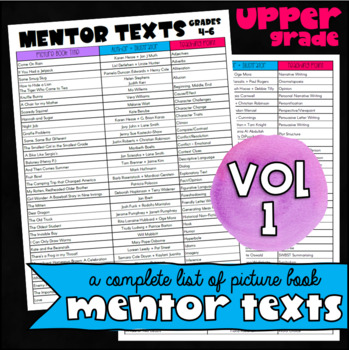Picture Book Mentor Text List for Upper Grade - VOL. 1
- PDF
What educators are saying
Also included in
- With this bundle, I've done the work for you! All picture book titles will guide students into discovering Author's Purpose, the ELA Common Core Standards, and the components of common writing styles taught in an upper grade classroom. More importantly, you will share amazing stories that are sure tPrice $6.50Original Price $8.00Save $1.50
Description
Behold! A complete list of picture books to use as mentor texts in your upper grade classroom!
I love reading picture books with my fifth graders. Not only do we share a good story, but students are also motivated to try new strategies in their own writing. From character development to figurative language to dialog to mechanics, we learn so much from the amazing books that we read aloud in class.
"By using mentor texts, the reader can virtually position him-or herself to sit beside the author and study how the text is constructed and how it communicates." - The Writing Thief, Ruth Culham
The 68 diverse stories on this list include a variety of characters, writing styles, and themes. When used as mentor texts, they will support the reading and writing standards while encouraging young authors to emulate new ideas in their own writing!
TEACHING POINTS:
- Adjectives
- Adverbs
- Alliteration
- Allusion
- Beginning, Middle, End
- Cause/Effect
- Character Challenges
- Character Change
- Character Traits
- Climax
- Compare/Contrast
- Conflict/Resolution
- Conflict - Emotional
- Context Clues
- Descriptive Language
- Dialog
- Explanatory Text
- Fact/Opinion
- Figurative Language
- Foreshadowing
- Friendly Letter Writing
- Generating Ideas for Writing
- Historical Non-Fiction
- Hook
- Humor
- Hyperbole
- Idioms
- Imagery
- Inference
- Informational Writing
- Lesson/Central Message
- Main Idea/Supporting Details
- Metaphors
- Narrative Writing
- Onomatopoeia
- Opinion
- Personal Narrative Writing
- Personification
- Perspective/Viewpoint
- Persuasive Letter Writing
- Persuasive Writing
- Plot Structure
- Poetry
- Point of View - 1st Person
- Point of View - 2nd Person
- Point of View - 3rd Person
- Predicting
- Problem/Solution
- Punctuation
- Punctuation: Commas
- Questioning
- Reading Illustrations
- Sensory Language
- Sequence/Order
- Setting
- Simile
- Suspense
- SWBST Summarizing
- Symbolism
- Task, Purpose, Audience
- Text + Graphic Features
- Text Connections
- Theme
- Transitional Phrases
- Visual Elements (RL.5.7)
- Vivid Verbs
- Vocabulary Acquisition
- Word Choice
☀️ CLICK HERE to check out Picture Book Mentor Texts for Upper Grade - VOL. 2!



